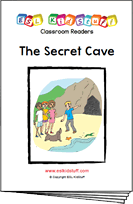Rooms of a house lesson plan
Stand-alone lesson ESL kids lesson plan
Lesson plans for ESL kids teachers
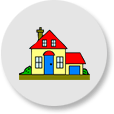
Rooms of a house
In this lesson students practice naming and describing different rooms and some common household objects in their homes. They also take a house quiz, make room posters and read a fun classroom reader.
Members get accompanying worksheets and classroom reader.
Download materials:
Our lesson plans are FREE!
Sign up for accompanying:
✔ worksheets
✔ homework sheets
✔ craft sheets
✔ flashcards
✔ song downloads & videos
✔ classroom readers & videos
Click to see lesson details, materials and supplies
Time: 40 mins – 1 hour
Objectives: Talking about different rooms of a house and household objects.
Structures: “What room is this?”, “Where in the house do you …?”, “[hide_on_uk]Do you have[/hide_on_uk][hide_on_us]Have you got[/hide_on_us] a/an (sofa)?”.
Target vocabulary: house, bedroom, kitchen, bathroom, living room, dining room, garden.
Lesson materials
Printables:
- Objects in my house worksheet
- Home plan worksheet
- Reader worksheet
Readers:
- Mr. Stretch’s house
Additional materials:
- Rooms vocab crossword
- Rooms vocab word search
- Which room? worksheet
Supplies:
- [hide_on_uk]colored[/hide_on_uk][hide_on_us]coloured[/hide_on_us] pencils
- magazines / [hide_on_uk]catalogs[/hide_on_uk][hide_on_us]catalogues[/hide_on_us] with pictures of household objects
- Blu-Tack or tape to stick pictures to the board
- large sheets of construction paper / card
- picture dictionaries (optional)
- board with marker / chalk
This lesson covers the main rooms of a house as well as vocabulary for some common household objects.
Lesson procedure:
Warm up and maintenance:
The beginning of your lesson is extremely important: this is where you set the tone of your lesson and get everyone in the right frame of mind for learning English. It is also an opportunity to check homework and review previous lessons.
Click for warm up suggestions for the start of your lessons
These activities can be done in the following order at the start of your lesson:

1. Greetings and name tags
Greet the students by name as they enter the classroom and gesture for them to sit down. Before class prepare some blank name tags (stickers or pin-on tags). Give these out and have everyone write their names and put their tags on. If you use pin-on tags, you can keep and give out every class.

2. Homework check
Check each student’s homework set in the last lesson. Ask each student some questions about their homework worksheet (e.g. “what [hide_on_uk]color[/hide_on_uk][hide_on_us]colour[/hide_on_us] is it?”), give lots of praise, and then put some kind of mark on the homework sheet (e.g. a sticker, a stamp or draw a smiley face). Finally, tell your students to put their homework back into their bags.
3. Review past lessons
Reviewing past lessons is very important – students need constant practice of new vocab, structures, songs, games and so on. Always review parts of your last lesson as well as some parts from other previous lessons. You can spend 5-10 minutes reviewing – it’s fine to recycle games and activities from your past lessons to review as kids enjoy playing familiar games (although be careful not to play a game to death!). See the section “Other ideas to include in your warm” below for ideas.
You can also include review activities in the main body of your lesson. Kids can have short attention spans so it’s good to be able to pull out lots of activities during different stages of the lesson.
Other ideas to include in your warm up:
Ball pass questions
This is good to review questions from previous lessons. Get everybody standing in a circle.
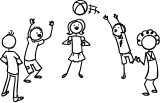
Round 1:
Take a ball and hold it and say, “My name is (you name)”. Then throw the ball to one student and say, “What’s your name?”. Students throw the ball around randomly, saying their names and asking for names.
Round 2:
This time ask a review question, e.g. “How many tables are there?”. Then throw the ball to a student who should answer, “There are (6) tables”. Help if necessary. Then that student throws the ball to another student and asks a “How many …?” question. Continue so everyone has a go. You can have multiple rounds with different topic questions.

Play “Spin the bottle”
Sit students in a circle with a bottle in the middle. Teacher spins the bottle. When it stops spinning the student it is pointing to has to answer a question. If the answer is correct then that student can spin the bottle. This is a good class warm up activity (e.g. How are you? What’s your [hide_on_uk]favorite[/hide_on_uk][hide_on_us]favourite[/hide_on_us] food? How’s the weather today?, etc.
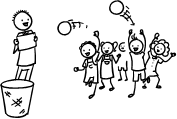
Play “Vocabulary basketball”
This is a fun game which reviews vocabulary from previous lessons. You will need a basket (a trash can) and 2 balls (or 2 pieces of A4 paper scrunched up into balls).
Form 2 teams and line them up so that two players from each team are facing the front with the basket in front of them. Let both players throw their ball – if they get their ball into the basket they can try and win a point by giving the correct answer to a question the teacher asks. This can be an actual question (e.g. What are you wearing?) or a flashcard (What’s this?). Then they go to the back of the line. At the end, the team with the most points is the winner!
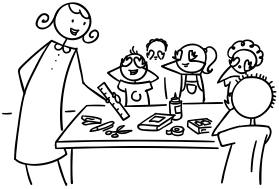
Play “What’s missing?”
This is a fun review memory game – students will have to try to remember review objects from previous lessons (e.g. classroom stationery). Lay the objects out on a table for all to see. Allow the students a minute to memorize the positions of the objects. Remove an object and hold it behind your back. Say, “Open your eyes!” – the first student who can shout out the missing object wins a point for his/her team. Play for all the objects.
Finally, calculate which team has won the most points and give them a round of applause.

Play “Quiz game show”
This is a fun quiz game, like a simple version of a TV game show. Draw some circles on the board and randomly write numbers 1, 2 or 3 in each circle. These will be points.
Put students into teams. Then ask the first team to choose a number – 1 is an easy question (e.g. “Do you like bananas?”) and 3 is a difficult question (e.g. point at a clock and ask, “What time is it?”). 2 will be in between in terms of difficulty. When the question has been answered correctly, erase that number circle. Play until all the number circles are gone – the team with the most points is the winner!
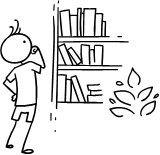
Read a classroom reader again
As you progress through the lessons you will start to build up a catalog of classroom readers (see our Readers download page at https://www.eslkidstuff.com). Kids love going back to old stories and reading through them again. Invite a student to pick a classroom reader and read through it as a class. Make the story as interactive as possible by asking questions (e.g. what [hide_on_uk]colors[/hide_on_uk][hide_on_us]colours[/hide_on_us] there are, the names of different objects, etc.) and getting students to speculate what is going to happen next in the story.

Talk about the weather (do after you have taught the weather lesson plan).
- Prepare a weather board. Before the first class prepare a piece of cardboard and cover it with felt – you are going to pin this to the wall. If you can, try and get blue felt (to represent the sky). Write at the top in large letters, “How’s the weather today?”. Below that write “Today it’s”. Cut out weather pictures (such as our weather flashcards) and stick some velcro on the back. Arrange the weather pictures around the edge of the board and then put the board on the wall of your classroom. You can now use this weather board at the beginning of every lesson.
- Ask about the weather. Ask, “How’s the weather today?” and have students put up their hands. Allow one weather condition per student (e.g. “It’s rainy”) and have each student come up and put a weather picture on the weather board.
- Introduce more weather vocabulary. Depending on weather conditions, you can introduce more weather words (with pictures … you can get students to draw them), such as:
- stormy
- misty
- showery
- freezing
- humid
- frosty
- icy
- drizzly
New learning and practice:
1. Teach rooms vocabulary
Before class, cut out 6 pictures of household objects from a magazine/[hide_on_uk]catalog[/hide_on_uk][hide_on_us]catalogue[/hide_on_us]: one for each of the rooms of a house, for example:
- bed (for the bedroom)
- refrigerator (for the kitchen)
- shower (for the bathroom)
- TV (for the living room)
- dining table (for the dining room)
- flowers (for the garden).
On the board draw a picture of a house, similar to below. Make sure you draw it as big as possible to fill the board.
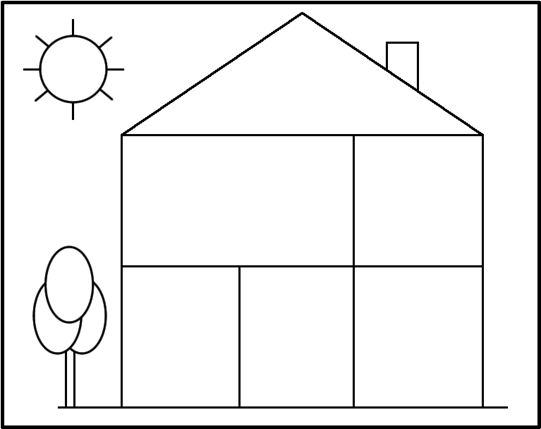
Elicit the words “house”, “tree” and “sun”. You can also teach/elicit “roof” and “chimney” as extra vocabulary.
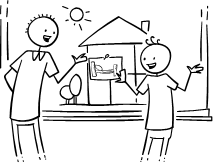
Next, hold up the cut out “bed” magazine picture and elicit/teach the word. Ask one student to come up to the board stick the picture in one of the rooms (make sure it is the large, upstairs room). Do the same with the other 5 pictures, each time eliciting the word and getting a student to stick on your house so that each room has a picture in it (and one outside in the garden).
Now, elicit/teach the words for rooms of the house and garden: point at the bedroom and ask, “What room is this?”. If no one knows, say, “Well, it has a bed and it is a room, so it’s a …” and try and elicit “bedroom”. Then write the word in the room and chorus 3 times.
Do a similar thing with the other places, e.g.
- bathroom: a room with a bath
- living room: a room where we live
- dining room: a room where we eat dinner (dinner room … dining room)
- kitchen/garden: not compound words so can’t teach this way – just teach and chorus.
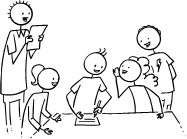
2. Play the “Rooms of a house quiz”
Put your students into groups (of 2-6 students per group, depending on how many students are in your class). Get each group to elect a team captain and then give each captain a piece of paper and pencil. Tell the captains to write the numbers 1 to 12 down the left-side of the paper. Each captain is going to write the 12 answers to the quiz questions on this sheet, but the rest of the group will help give him/her the answers.
The teacher reads out the following questions as the groups write the answers on their sheets:
- Where in the house do you brush your teeth? (bathroom)
- Where in the house do you cook food? (kitchen)
- Where in the house do you sleep at night? (bedroom)
- Where in the house do you eat dinner? (dining room)
- Where in the house do you sit with your family and watch TV? (living room)
- Where do you see grass? (garden)
- Where are your books, toys and games? (bedroom)
- Where are the dishes washed? (kitchen)
- Where can you sunbathe? (garden)
- Where does your family relax together? (living room)
- Where can you get wet inside your house? (bathroom)
- Where is the largest table? (dining room)
Finally, go through the answers with the class by pointing to the correct room on your board picture and helping out with any vocab that students don’t understand. The winning group gets a round of applause from everyone.
3. Do “Rooms of a house posters”
Put your students into 6 groups (for smaller classes, 3 groups is fine). Give each group the following:
- one large piece of card / construction paper
- a magazine/[hide_on_uk]catalog[/hide_on_uk][hide_on_us]catalogue[/hide_on_us] with lots of photos of household objects (at least one per group)
- scissors and glue
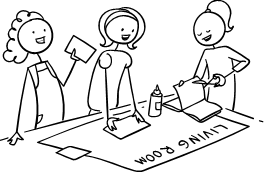
Assign each group a room of a house (or garden) and get the groups to write the room name at the top of their construction paper. So, for example, one group will make a “bedroom” poster, another a “living room poster”, etc. If your class is small and you only have 3 groups, each group will have two pieces of construction paper (therefore they will do two room posters).
Tell everyone to look through their magazines/[hide_on_uk]catalogs[/hide_on_uk][hide_on_us]catalogues[/hide_on_us] and cut out pictures to stick on their poster for their room. Demonstrate this with one room before you start to make sure everyone understands (e.g. in living room: a sofa, a TV, rug, coffee table, etc.).
Give students 5 minutes for this.

When each group has finished, tell everyone that they have to write the words for the things they have stuck on their posters. Having picture dictionaries or even use of a smart phone is ideal for students to find the words. Another alternative is a [hide_on_uk]catalog[/hide_on_uk][hide_on_us]catalogue[/hide_on_us] in English. If you don’t have any of these resources, you can help students with the words they don’t know. By the end, all of the pictures should be labeled correctly.
When all of the posters are complete, get each group to stick theirs to the walls of the classroom – try and get them evenly spaced around the room. Then have students present their posters to their classmates.


4. Play “Touch the picture”
Get everyone to sit in the middle of the classroom. First, the teacher goes to each poster and choruses each picture 2 or 3 times (e.g. “bed, bed, bed”). Do this quite quickly to avoid students getting bored.
Next, tell everyone that you are going to say an object and everyone has to race to touch it on the poster. The first person to touch it is the winner. Shout out a word (e.g. “shower!”) and everyone rushes to touch that picture. Then continue shouting out other words, as students race around the room touching objects on the posters. This should be fast paced and fun.
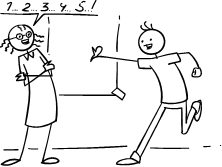
5. Play “Touch the picture” in pairs
Now, pair up students. Student A will say an object from any poster and Student B has to find and touch it. Sounds easy? Well, give a time limit for the students to find and touch the picture (e.g. 5 seconds – depending on the levels of your students). For example:
Student A: Find a lamp! 1 … 2 … 3 … 4 … 5 … Time’s up!
Student B: (runs around searching for a lamp picture to touch)

6. Do the “Objects in my house” worksheet
Give out the worksheets. First, get students to write the words for each room on their worksheets. Then get the students to use the posters around the room to write words and draw pictures of the objects they have in their home.
If students don’t have certain rooms in their homes (e.g. dining room, garden) have them put in objects they have in other rooms that could go in those rooms.
When everyone has finished, put students into pairs. Teach the phase:
[hide_on_uk]Do you have[/hide_on_uk][hide_on_us]Have you got[/hide_on_us] a/an (sofa)?
Then have pairs ask each other about what they have and don’t have in their homes using their worksheets as a guide.
7. Read classroom reader “Mr. Stretch’s house”
Let’s end with a fun story that practices the vocabulary in today’s lesson. Before class, download and print off the reader “Mr. Stretch’s house”. As you go through each page, point to the pictures and elicit the rooms, as well as other vocabulary for the objects in the rooms, for example:
Teacher: (pointing at the picture on page 4) What room is this?
Students: The kitchen!
Teacher: Yes, that’s right! What is Mr. Stretch getting?
Students: A banana!
Teacher: Yes, good job! He’s stretching his arm all the way into the kitchen to get a banana! And where is he getting the banana from (pointing at the refrigerator)?
Students: A refrigerator!
Teacher: Yes, that’s right! (Reading) “He is getting a banana from the fridge!”. Do you have a refrigerator in your kitchen, Kate?
Kate: Yes, I do!
Teacher: And do you have bananas in your refrigerator?
Kate: Um, no.
Teacher: Kate doesn’t have bananas in her refrigerator. Does anyone here have bananas in their refrigerator?
David: Yes, I do!
Teacher: Ah, David does! What other food is in your refrigerator?
David: Um. Ham and eggs and milk.
Teacher: Very good, David! Ok, everyone, what else is in Mr. Stretch’s kitchen?
Students: A cooker!
etc.
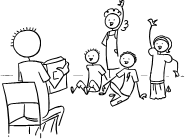
Get the students really involved in the story by asking lots of questions about the what objects they have in their homes.
After reading the story, give out a reader worksheet to each student and read through the story one more time (without stopping for questions, etc.) as students match the objects in the story to the different rooms. Then go through the answers as a class.
Alternatively, watch our video version of the reader (Internet connection required).
Wrap up:
Assign homework: “Home plan” worksheet
Click for wrap up suggestions for the end of your lessons

1. Assign homework
Each week give out a homework worksheet for your students to take home. Hold up the homework worksheet and model how to do it. Give out the worksheets and say, “Put your homework in your bags”.

2. Do “Quick check”
Time to leave the class. Make sure everything is put away and the students have gathered their belongings. Have them line up at the door and place yourself between the door and the students. For each student check one new word or phrase, for example:
- hold up an object or flashcard (such as an item of clothing) and ask, “What’s this?”
- ask a question from the lesson (e.g. “Where do you live?”, “Do you like bananas?”, “Can you play chess?”, etc.)
When they give you the correct answer say goodbye and let them leave. If their answer is wrong, have them go back to the end of the line – they will have to try again once they reach the front!
Other lesson plans
Actions, verbs & tenses:
- Can – for ability
- Morning routines
- Daily routines & times of the day
- Actions – Present continuous
- Future plans using “going to”
- Past tense activities – Regular verbs
- Past tense activities – Irregular verbs: Part 1
- Past tense activities – Irregular verbs: Part 2
Adjectives:
- Describing people
- Describing things
- Comparing things (Comparative adjectives)
- Comparing things (Superlative adjectives)
Adverbs:
Alphabet:
Animals:
Body:
Classroom:
Clothes:
Colors:
Colours:
Directions:
Family:
Feelings & emotions:
Food:
Health & sickness:
Holidays & festivals:
Jobs:
Likes, dislikes & favorites:
Likes, dislikes & favourites:
- Likes & dislikes
- [hide_on_uk]Favorites[/hide_on_uk][hide_on_us]Favourites[/hide_on_us] and asking why
Nature & Our world:
Numbers:
Places & where we live:
Prepositions of location:
Pronouns:
Shapes:
Shopping:
Sports:
Time, days, months, seasons:
Toys:
Transport & travel:
Weather:





